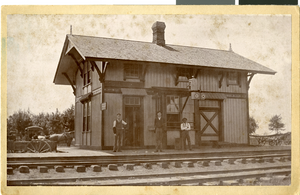Search the Special Collections and Archives Portal
Search Results

Photograph of southern commuter outside San Diego, circa late 1800s to early 1900s
Date
Archival Collection
Description
Image

Photograph of men in front of building, Gilliam, Missouri, circa late 1800s to early 1900s
Date
Archival Collection
Description
Image

Film transparency of a Las Vegas and Tonopah Railroad Company train car, Las Vegas, circa early 1900s
Date
Archival Collection
Description
Image
Mallory H. Ferrell Photograph Collection
Identifier
Abstract
The Mallory H. Ferrell Photograph Collection (approximately 1900-1935) is comprised of nine black-and-white photographic prints depicting railroads, locomotives, and mines in Tonopah, Nevada and Tecopa, California.
Archival Collection
J. Ross Clark Photograph Collection
Identifier
Abstract
The J. Ross Clark Photograph Collection (approximately 1900-1920) consists of black-and-white photographic prints and some corresponding negatives. Images depict J. Ross Clark, his wife Miriam Evans Clark, their grandson James Ross Clark II, and several unidentified individuals.
Archival Collection
Arthur Walker Gregory Photograph Collection
Identifier
Abstract
The Arthur Walker Gregory Photograph Collection, approximately 1900 to 1920, consists of black-and-white photographic prints, and two corresponding negatives. Two of the images depict the first train to arrive in Las Vegas, Nevada from Salt Lake City, Utah in 1905, one with railroad employees in the foreground. The remaining images depict Arthur Walker Gregory’s class photographs at the Las Vegas Grammar School when he was in the first, third, and fifth grades.
Archival Collection
Maurine and Fred Wilson and Dr. William S. Park Photograph Albums
Identifier
Abstract
The Maurine and Fred Wilson and Dr. William S. Park Photograph Albums (1900-1930s) consist of twelve albums containing black-and-white photographic prints and three black-and-white photographic negatives. The photographs are primarily related to the families of William S. Park, John S. Park, and Fred and Maurine Hubbard Wilson. Included are images of the Park homes in Las Vegas, Nevada; Park and Wilson family members; scenes of early Las Vegas, Nevada; outdoor activities, and vacation trips to California, Colorado, and Mexico.
Archival Collection
Jeff McColl Sr. oral history interview
Identifier
Abstract
Oral history interview with Jeff McColl Sr. conducted by Dennis L. Weigang on March 09, 1976 for the Ralph Roske Oral History Project on Early Las Vegas. In the interview, McColl discusses his early life moving back and forth between California, Nevada, and Texas before settling in Las Vegas, Nevada in 1925. McColl also discusses his work as a locomotive engineer for the Union Pacific Railroad Company, life in Las Vegas during the late 1920s and 1930s, and industrial and urban growth in Las Vegas.
Archival Collection
Albert C. Phillips Photograph Collection
Identifier
Abstract
The Albert C. Phillips Photograph Collection is comprised of sixteen black-and-white photographic reprints and four photographic negatives depicting buildings in Caliente, Nevada which were originally taken between 1900 to 1967 and reproduced in approximately 1999 to 2005.
Archival Collection
Howard Wasden oral history interview
Identifier
Abstract
Oral history interview with Howard Wasden conducted by Gillian Collins on an unknown date in the 1970s for the Ralph Roske Oral History Project on Early Las Vegas. In this interview, Wasden discusses arriving in Las Vegas, Nevada in 1925 and working for the railroad. Wasden explains how the railroad was a predominant economic asset for Las Vegas at the time. He then describes living on the Westside "Old Town", education in Las Vegas, attending the University of Nevada, Reno, and eventually becoming a teacher. Lastly, Wasden discusses the population growth, development of the Las Vegas Strip, and his role as principal of West Charleston School.
Archival Collection
